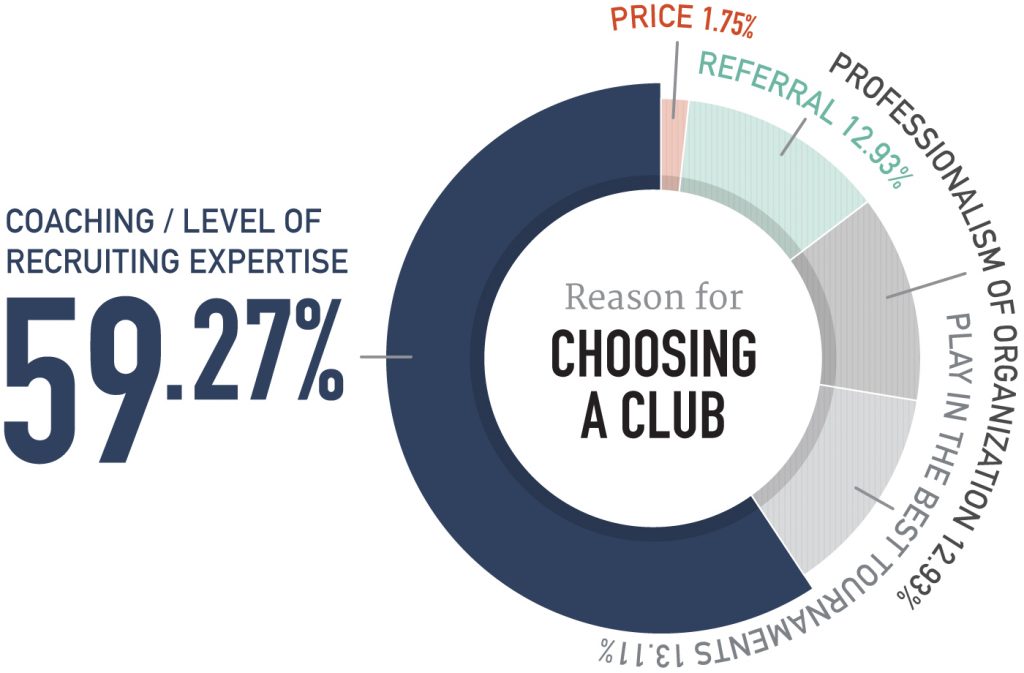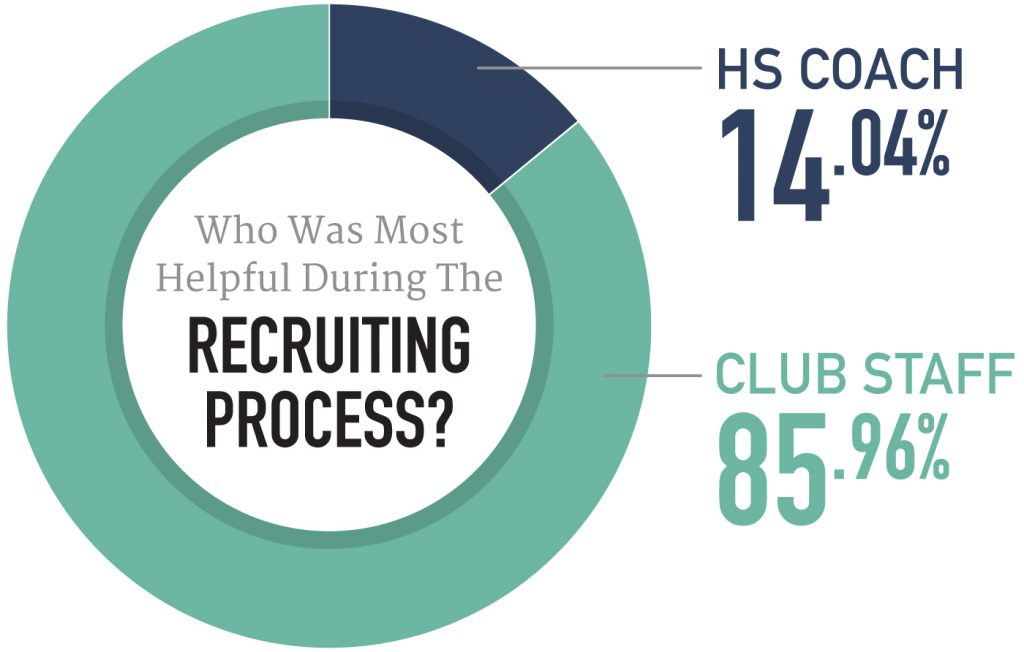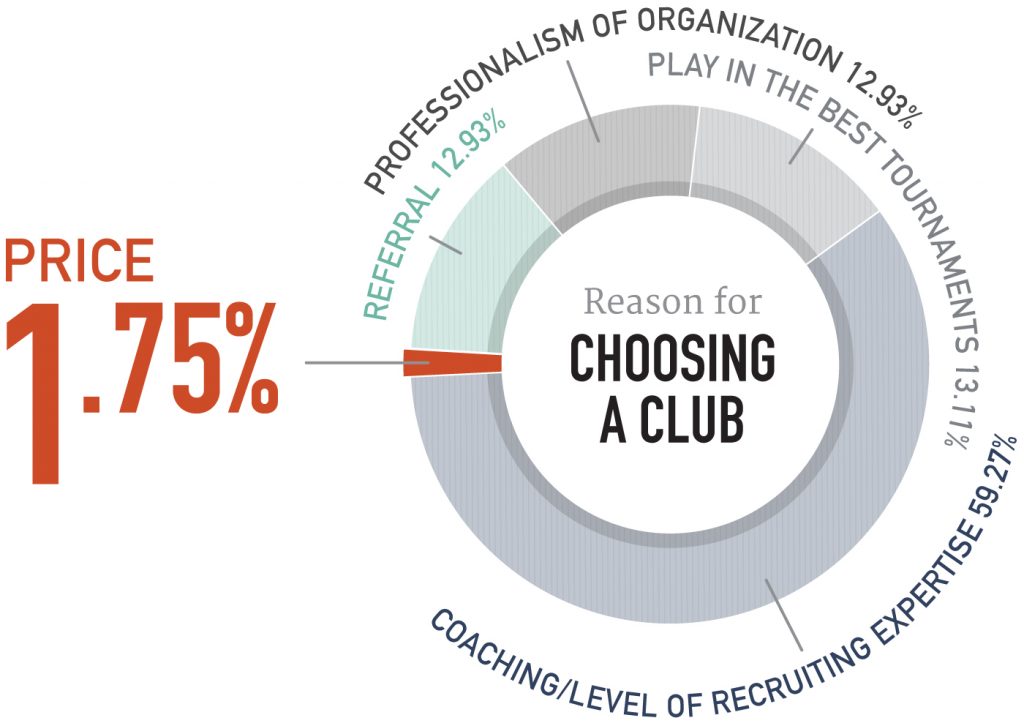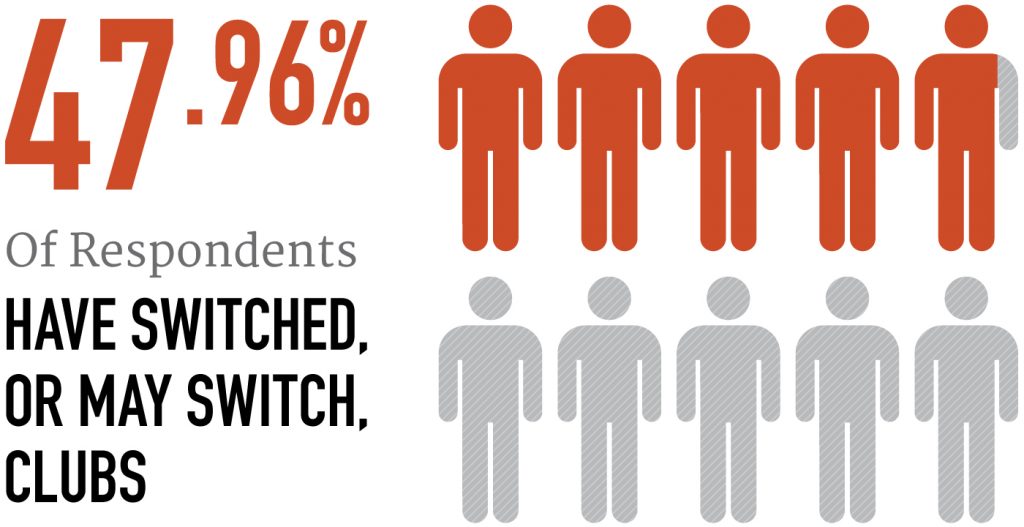Recently, SportsRecruits sent a 10-question survey to its members on club teams. The goal was to gain insight into the thought processes of these families as they relate to their club sports experience.
In all, 706 families responded anonymously to our survey. All responses were voluntary, and users were not required to answer each question. Below are some of the most illuminating findings as per their relevance to club owners and directors.
We broke each finding into a few parts.
First, you will see the question, as well as an infographic depicting the results.
Second, you will see comments which provide perspective from the families that help shed more light into the numbers.
Third, you see what we feel is the most important data point from that question.
Lastly, you will see our analysis of the data points.
SURVEY RESULTS
Question #1
Which of the following most accurately reflects why you chose your current club program?
Respondent’s Answers
“It is all about college – getting into a better one.”
“[Redacted] is horrendous about recruiting unless you are one of the coach’s favorites or play for the high school team. They did not even help with my older son who now plays [in college]. [Redacted] is a cash machine for the owners. They hate parents. This is the primary reason why we switched [clubs].”
Takeaway Data Point
59.27% of respondents (339 of 572) noted that they chose their club team primarily for the coaching and level of recruiting expertise.
Analysis
It is interesting to see a number behind what has been anecdotally true for many years: Families are relying on their clubs for guidance in the recruiting process. College will be the most significant investment a family makes outside of a house.
Looking at the respondents’ answers, we can see that negative feelings toward a club’s handling of the recruiting process can directly lead to them leaving an organization. This feels like a logical step when considering that over half of the families surveyed are choosing a club primarily for recruiting assistance.
Considering families are choosing clubs for their recruiting acumen, it is vital that organizations have a bulletproof system and/or the technology in place to handle these needs effectively.
Losing a family can be a real issue as an organization attempts to scale. As we know from our recent look at customer churn, it would be wise for clubs to continue doing everything in their power to keep their families happy.
The idea of customer churn – a fancy way of saying how many customers a business loses – is simply that an organization will be unable to grow if they are simply replacing customers as opposed to retaining them.
Depending on how many age groups a club supports, 85-90% of revenue organizations see each year comes from renewals, while only 10-15% are from new players. Thus, simply replacing families means losing the revenue that can be gained from keeping them on board.
We will revisit this question a bit later to explore another interesting trend in the answers provided.
Again, you can learn more about churn here.
Question #2
Which of these people would you say you rely on the most in the recruiting process?
Respondent’s Answers
“Both the Coach and Recruiting director have been very helpful.”
“None of the above as they are all one person and not particularly hands-on with the recruiting process. We rely on friends with older children who have gone through this.”
“Really none, I feel alone in this, and I need help because it feels like it’s getting late.”
Takeaway Data Point
85.96% of respondents (508 of 591) noted that a club staff member (director, coach or recruiting coordinator) was relied on the most for needs in the recruiting process.
Analysis
Taking the first question and digging deeper, we can see just how much families expect from their club staffers, notably as it relates to recruiting assistance.
When breaking down some of the respondents’ comments, it was also interesting to note how many said they felt lost in the process or were simply not getting what they thought was adequate assistance. This suggests that a gap exists between expected and real value when it comes to guidance in the recruiting process from a club.
We recently discussed the topic of adding recruiting value, noting it was an important step in keeping families happy – and these numbers would certainly add credence to this idea.
Investing in technologies, speakers or other ways to add recruiting value to your club’s infrastructure can then be viewed as a solution to meet the continued demands from families on an organization.
Question #3
Which of the following most accurately reflects why you chose your current club program?
Respondent’s Answers
“Well run program. Good reputation for players and development.”
“Coach philosophy and expertise are topmost.”
Takeaway Data Point
Only 1.75% of respondents (10 of 572) selected “price” as a major factor of joining a club.
Analysis
As promised, we are back to this question, which provides another interesting point.
Given the rising costs of playing on a club team – things like event fees and travel expenses alone are astronomical – it is interesting to note that price is not a major factor for our respondents when choosing an organization.
While this at first appears surprising, it should not be. Families have begun to view club sports as an expense that will ultimately result in finding a collegiate home. Considering the exploding costs of a college education, families view a $1,000-$5,000 per-year cost as an investment.
Other than buying a house, sending a child to college is one of the largest costs a family will incur. As such, it is not surprising that they are willing to invest in club sports as a way to potentially offset costs later via scholarships.
With budgets and costs on the minds of most club owners and directors, it is interesting to note that price does not seem to be such a determinant factor. While there certainly exists a yet-to-be-calculated ceiling on what a family will pay, it does not seem to have been reached yet.
If you are a club not making investments in your business when it comes to technology and infrastructure, families will find and pay a premium for those that are.
Said another way, there is no reason for an organization to cut corners or to invest in things like technology, personnel or other value-add improvements if price is not a deterrent for families.
Question #4
Have you in the past or would you consider changing clubs in the future?
Respondent’s Answers
“Recently changed clubs to more high profile club to better get exposure.”
“My son has played on club teams since 4th grade and he has played for 3 different clubs.”
“We play for multiple clubs. There is no loyalty. You need to do what’s best for the kid not the team. So sad to youth sports go this way. The overall experience is pretty lame.”
Takeaway Data Point
47.96% percent of respondents (294 of 613) have switched clubs or are unsure if they will switch clubs.
Analysis
This is one of the most important statistics we found in our survey. With the idea of customer churn in mind (and again, here is our paper on this subject), the fact that a number that represents almost half of the respondents have changed clubs or aren’t sure if they will should scare any business owner looking to grow their business.
Two concerns arise from this data point:
1. Families will not hesitate to do what they believe is in their child’s best interests.
2. Losing customers will not only hurt a club’s ability to grow revenue, but will also hurt its reputation, which in turn will affect prospective future clients.
Looking at this more positively, there are tangible ways to invest in an organization to keep a family happy. For example, being able to demonstrate where you are adding value and treating all families with equal care and attention are two ways in which a club can keep its members on the same page.
Using things like feedback surveys and holding meetings are also great ways to add value.
The numbers indicate it is of paramount importance to keep families happy, and to do so requires the ability to show an organization is doing everything in its power for them.
Question #5
Does your club assist with highlight reels?
Takeaway Data Point
72.12% of respondents (445 of 617) noted how their club does not assist them with highlight reels.
Analysis
We have established that families largely join clubs for their acumen as it relates to the recruiting process. We have learned that price does not seem to be a huge concern at present, families are not hesitant to leave a club, and that this absolutely will hurt an organization looking to grow.
It is no secret that highlight reels are one of the most important aspects of the recruiting process. Yet, the numbers suggest most clubs do not concern themselves with this.
Perhaps this is because it can be an annoyance, costly or some combination of other factors. However, in the competition to keep families and keep them happy, there seems to be a natural opportunity in video to provide real value.
With the youth sports space so large, there are no shortage of companies providing video and other services. It would be wise for a club to affiliate with them in some way and facilitate the building of highlight reels.
Again, this can be looked at as an investment into the club in order to keep families engaged while providing them the best service possible.
Conclusion
The findings from our survey can be summarized in a fairly succinct manner: Families are choosing clubs with the recruiting process in mind, are heavily relying on their clubs for assistance in the recruiting process and are willing to move clubs to find what they perceive will be the most helpful situation that will lead to finding a collegiate home.
One interesting outcome of this survey was putting data behind what many in the club sports space have known anecdotally for some time. This is meaningful because it is coming directly from the minds of the families currently going through the recruiting process.
Ultimately, any club organization would be wise to listen to the pulse of their customer base in order to adapt as necessary to meet their needs in the most efficient and effective manner possible.
To see how SportsRecruits can help your club, schedule a demo here or call us at 917-525-2101







